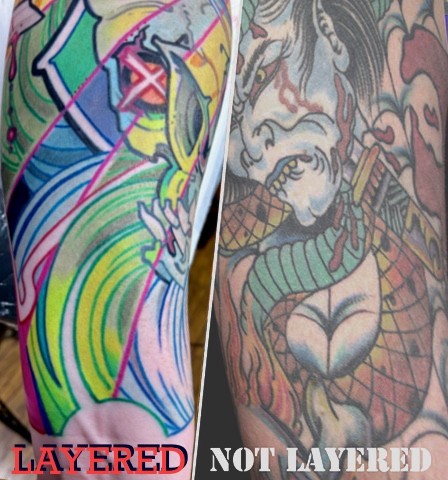THE PROCESS AT WORK
A standard or non-layered tattoo is what 95% of all the tattooers out there are doing. Very few artists use or even truly understand all the benefits of layering.
Here I compare a photo of a tattoo I did with another that was sent to me as reference by a client some time ago. My apologies for the low res photo of mine, as well as to the original artist of the non-layered work whoever you are.
Notice how fresh and new the layered tattoo still looks. The color is milky and thick and vibrant. Even after abuse in the sun. In the other one notice how dull and washed out it is. Even when done well, color will break apart little by little over time and show open spots, imperfections, patchyness and thin color around pores and such. It is the nature of the skin and a tattoo. Tattooing is an imperfect art by nature. The medium itself is in a constant state of degradation.
Protecting against that means building up the colors over several passes, aka separate sittings. Not unlike building up an oil painting to add depth and nuance. It can allow subtle gradients, detail and color vibrancy that could never be expected to keep long term in any other way.
Think of it this way: In a perfect scenario one properly done pass over a tattoo that is applied perfectly results in 100% of ink saturation for that day. Even in perfect conditions a minimum of 20-30% is left in the skin after healing. Even an entirely successful heal unavoidably reduces the amount of pigment left in the skin compared to its freshly done state. With a quick second pass you can not only make up that missing 30% but you can still add another additional 30% to add extra depth and brightness as well as protecting against aging for an additional 50% longer than standard tattooing. This second layer is so much faster and lighter than the original it is really more like a half layer and only adds another 20-30% more time than standard tattooing. The benefits far outweigh the added time and you get a tattoo that looks brighter and sharper and better like brand new for way longer. This is what top rate tattooing looks like and this is how exceptional tattoos are made.
